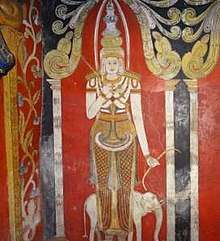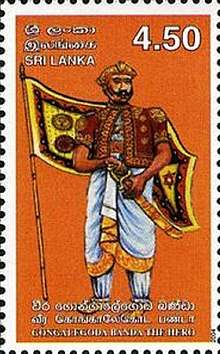Dewa (people)
Dewa tribe of Sinhalese in Sri Lanka is the only ancient Sinhalese tribe which still could be recognize in the island who founded Sinhalese nationality. There family names bearing distinct "Dewage" as surname. Deva, Wahumpura, Wanshapurna are the other names. They are mountain dwelling people even at present.
| Regions with significant populations | |
|---|---|
| Sri Lanka, Kerala | |
| Languages | |
| Sinhala language Dewa in Sri Lanka, Malayalam language Theyyar in Kerala | |
| Religion | |
| Buddhism with Sinhalese Hinduism with Theyyar in Kerala | |
| Related ethnic groups | |
| Sinhalese people, Ezhava |


Migration to Kerala
Some Deva people migrated to of Kerala where they followed Buddhism before the advent of Brahmanism. Having their own complete social fabric and systems of precedence and worship, they dominated the area until their power was seriously undermined by the Brahmin lead power lobby. However, they still survive in Malabar and are known as *Ezhava or "Thiyya", a localization of the name "Deyva" equivalent to Deva.
Thiyyar dynasties in Kerala
Thiyyar dynasties such as the Mannanar, Chekavar existed in Kerala at the present day Kannur and Kasaragod districts of India. They may have had a Buddhist heritage. Chekavar is a warrior section within the Thiyyar community, served the army of the Chera dynasty. There were also renowned Kalaripayattu experts among Chekavars.
Kalaripayattu
Kalaripayattu also known simply as Kalari, is a martial art and fighting style that originated in modern-day Kerala. Kalaripayattu is held in high regard by martial artists due to its long-standing history. With its origin in the martial arts timeline dating back to at least the 3rd century BCE.
Theyyam Festival
The ancestor worship of Thiyyas springs from the fact that they consider themselves as descendants of "Deyva" or God. The ceremonial oracles, who represent the spirit of their ancestors of Lanka, in the temple are known as "Theyyam", originating from the word "Deyvam" meaning God.
See also
A few prominent members of the Deva (Wahumpura) community
- Saman (deity) legendary history, Sumana Saman invited Lord Buddha to the Samanala Kanda to left his foot print on the top of the mountain - The first king of Sri Lanka
- Kanchadeve a senior military leader to King Dutugamunu's army 161 BC to 137 BC
- Pussadeve a senior military leader to King Dutugamunu's army 161 BC to 137 BC
- Gongalegoda Banda (Wansapurna Dewage David alias Gongale Goda Banda) (a.k.a. Peliyagoda David) (13 March 1809 – 1 December 1849 ) - The last king of Sri Lanka
- Henry Pedris (Duenuge Edward Henry Pedris) (Sinhala: හෙන්රි පේද්රිස්; (16 August 1888 – 7 July 1915)
- Cyril Mathew (Kaluwa Dewage Siril Mathew) Former Cabinet Minister; JR Jayawardana's government (September 30, 1912, October 17, 1989)
- Athula Nimalasiri Jayasinghe (Wijayamuni Devage Athula Nimalasiri Jayasinghe or Loku Athula) (1944 - 2014) Deputy Minister of Power and Energy
- Ananda Kularatne Minister of Southern Region Development (2001–2004)
- Semage Salman Kulatileke Member of the Sri Lanka Parliament (1970–1972)
- Wijeyadasa Rajapakshe Minister of Education and Higher Education and many ministerial posts
- Champika Premadasa (Abathenna Devayalage Champika Premadasa) (November 4, 1948) Minister of Industry and Commerce and State Minister of Industry and Commerce 2015-2019
- Gunaratna Weerakoon (Muhudugama Hewage Gunaratna Weerakoon) 10 November 1947 Non-Cabinet Minister of Nation Building (2007–2010)
- K. D. Lalkantha - Former parliamentariyan and unian leader of JVP
- Nanda Mathew (Kaluwa Dewage Nanda Mathew) was former Governor of Uva province (held the office from 2003 to 2015)
A.G. Sirisena - Provincial Council Member of central Province from SLFP
- N. D. N. P. Jayasinghe - Former parliamentarian from JVP and Provincial Council Member of central Province from JNP (SLFP Alliance)
- Samson Rajapaksa (Diyunuge Samson Rajapaksa) JP (Industrialist *DSI Samson Group)
- Dharma Sri Munasinghe Sinhala radio playwright and film screenwriter and director
- Douglas Ranasinghe An actor in Sri Lankan cinema, theater, and television
- Neville Karunatilake, Former Governor of the Central Bank of Sri Lanka
References
- Dr. K. D. G. Wimalaratne, Director, National Archives, Gongale Goda Banda (1809-1849) : The leader of the 1848 rebellion accessed 5 December 2005.
Sumana Saman was a leader of the Deva who came from the central hills of Sri Lanka.[1] Some Sri Lankan Buddhists worship him as a deity.[2] He is said to be the guardian of Samanalakanda.[3]
- 53rd Death Anniversary on December 1 : Gongalegoda Banda - Leader of the 1848 Rebellion, by Dr. K. D. G. Wimalaratne, Director, National Archives
- ‘Mahathala Hatana’: ITN's latest tale of Sri Lankan heroes
- Gongalegoda Banda in Sinhala
- Gananath Obeyesekere (2017). "Between the Portuguese and the Nāyakas: the many faces of the Kandyan Kingdom, 1591– 1765". In Biedermann, Zoltan; Strathern, Alan (eds.). Sri Lanka at the crossroads of history. London: UCL Press. ISBN 9781911307846.
- Jayatissa, Gunapala (6 June 2011). "දුක්ගන්නාරාළ නොහොත් අප්පුහාමිවරු". Divaina (in Sinhala). Retrieved 2 February 2013.
- Cyril Tamil Militant Groups
- Cyril Mathew's obituary
- ‘Mahathala Hatana’: ITN's latest tale of Sri Lankan heroes
^ Radhakrishnan, M. G. (5 September 2012). "Caste-based organisations NSS, SNDP form Hindu Grand Alliance in Kerala". India Today. ^ "Guess who's after the Hindu vote in Kerala? (Hint: It's not BJP)". Firstpost. ^ a b c d e f g Nossiter (1982) p. 30 ^ Mandelbaum, David Goodman (1970). Society in India: Continuity and change. University of California Press. p. 502. ISBN 9780520016231. Another strong caste association, but one formed at a different social level and cemented by religious appeal, is that of the Iravas of Kerala, who are also known as Ezhavas or Tiyyas and make up more than 40 per cent of Kerala Hindus ^ Gough, E. Kathleen (1961). "Tiyyar: North Kerala". In Schneider, David Murray; Gough, E. Kathleen (eds.). Matrilineal Kinship. University of California Press. p. 405. ISBN 978-0-520-02529-5. Throughout Kerala the Tiyyars (called Iravas in parts of Cochin and Travancore) ... ^ Kusuman, K. K. "Ezhavas: Their many dimensions". Newindpress.com. Archived from the original on 29 September 2007. ^ "Standing Committee on Social Justice and Empowerment (2006-2007)" (PDF). p. 13. ^ Kodoth, Praveena (May 2001). "Courting Legitimacy or Delegitimizing Custom? Sexuality, Sambandham and Marriage Reform in Late Nineteenth-Century Malabar". Modern Asian Studies. 35 (2): 350. doi:10.1017/s0026749x01002037. JSTOR 313121. ^ Pullapilly (1976) pp. 31–32 ^ Rao, M. S. A. (1979). Social Movements and Social Transformation. Macmillan. p. 23. ^ Randhawa, Mohinder Singh; Nath, Prem (1961). Farmers of India. Indian Council of Agricultural Research. p. 359.
CWC-led UPFA set to secure plantation region by Shamindra Ferdinando. The Island Online, 2010. Retrieved 11 July 2011
- Duruthu Poya - The Buddha’s first visit to Lanka. (2009). Gamini Jayasinghe. Available: http://www.amarasara.info/hotnews/20091231-02.htm%5B%5D. Last accessed 17 March 2010.
- W. L. Wijayawansa . (2009). Curbing the tribesmen . Available: http://www.dailynews.lk/2009/12/31/fea25.asp Archived 29 January 2013 at the Wayback Machine. Last accessed 17 March 2010.
- A.G.S. Kariyawasam . (1995). The Gods & Deity Worship in Sri Lanka. Available: http://www.lankalibrary.com/myths/gods.htm. Last accessed 17 March 2010.